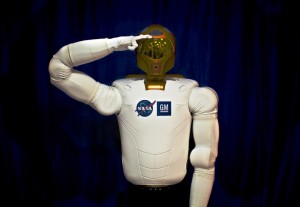General Motors and NASA engineers continue to prepare Robonaut 2 for its planned September mission to the International Space Station aboard the space shuttle Discovery, GM said today in a statement.
This new generation robot can use its hands to do work beyond the scope of prior machines.
Using dexterous, human-like robots capable of intricate work is not new to the aerospace industry, of course. The original Robonaut, a humanoid robot designed for space travel, was built by the software, robotics and simulation division at NASA’s Johnson Space Center in a collaborative effort with the Defense Advanced Research Project Agency 10 years ago
R2 can work safely alongside people, a necessity both on Earth and in space. This new generation robot can use its hands to do work beyond the scope of prior machines. (See NASA and GM Working on Robotic Technology)
GM and NASA engineering teams are currently checking on some of the key technologies employed by the “humanoid” robot, including advanced sensor and vision systems.
R2, while not nearly as cute as R2-D2 of Star Wars fame, is faster, more dexterous and a more technologically advanced robot than previous, non-movie versions.
No word if R2 has a taser, though.
At least people, so far, are doing the design work. Moreover, a human writes this story.
GM says engineers on site at NASA’s Johnson Space Center in Houston, Texas are sharing their results with colleagues at GM’s Technical Center in Warren, Michigan so teams working on future Chevrolet, Buick, GMC and Cadillac cars and trucks can develop “innovative safety technologies that will keep customers safe in the future.”
What is not said is that the technologies in use can completely eliminate the need for assembly line workers – a contentious issue that pits the United Auto Workers Union against U.S. taxpayers who hold a majority interest in the privately held company, and need GM to decrease its costs and increase its sales to retrieve the $50 million invested to have GM emerge from bankruptcy one year ago.
Manufacturing engineers in GM’s Research and Development operations also plan to use the findings to help develop future technologies that can make plants safer for workers at GM’s global manufacturing facilities.
R2’s technologies have potential applications for sensor development, such as enhancements to lane departure warning, side blind zone alert, adaptive cruise control and rear park assist systems, among others.
GM and NASA engineers have been working together on the R2 program since 2007. The advanced robotics partnership has generated 34 patents to date.
(See also Chrysler and NASA Pair on Advanced Technologies)


If I could fault NASA with anything over the years, it’s their marketing. They should be in our face every minute with what they have accomplished and how the technology has improved the world we live in.
Every American should be proud of our space program and understand that this is money well spent for the future and not a luxurious spending of tax dollars.
This joint project is incredible. We should all be in awe of our engineering feats that would not exist without our dedication to NASA.